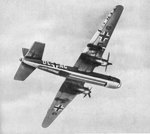He 177 Greif
| País | Alemanha |
| Fabricante | Heinkel Flugzeugwerke |
| Função Principal | Bombardeiro Pesado |
| Primeiro Voo | 19 nov 1939 |
Contributor: C. Peter Chen
ww2dbaseThe He 177 Greif ("Griffin") were long-range heavy bombers of the German Luftwaffe. An unusual feature in the design called for two engines in each nacelle driving a single propeller, which was a result of the German Air Ministry's demand that He 177 bombers should be capable of dive bombing, which was impossible with four propellers. This unique engine configuration, unfortunately, increased the chance of accidental fire as any oil leakage would drip onto the hot exhaust manifolds on the two middle cylinder banks. The frequent fires with earlier variants of the He 177 design led to the nickname Reichsfeuerzeug, "the lighter of the Reich"; the problem with fires was never totally resolved in later variants. Because of the dive bombing requirement, the wing and structure were strengthened beyond a typical bomber design called for, therefore He 177 bombers' speed and bomb load to suffer. In the end, they were only able to achieve shallow dive attacks, so most were used as a heavy bomber only. When production ended due to the Fighter Emergency Program of 1944 which called for a halt in all bomber production in favor of fighters, 1,184 aircraft were built.
ww2dbaseA small number of true four-engined variants were built under the designation He 277, but because they were not officially sanctioned by the Luftwaffe, the variant never entered production.
ww2dbaseSource: Wikipedia.
Last Major Revision: Jun 2007
He 177 Greif Timeline
| 19 nov 1939 | The Heinkel He 177, the German Luftwaffe's only real heavy bomber of the war, took its first flight. |
SPECIFICATIONS
A-5
| Machinery | Two Daimler-Benz DB 610 (twin DB 605) 24-cylinder liquid-cooled engines, rated at 2,950hp each |
| Armament | 1x7.92mm nose MG 81J, 1x20mm ventral MG 151, 2x13mm forward dorsal MG 131, 1x13mm aft MG 131, 1x20mm tail MG 151, up to 7,200kg of bombs or two mines, missiles, or torpedoes |
| Crew | 6 |
| Span | 31.44 m |
| Length | 22.00 m |
| Height | 6.70 m |
| Wing Area | 100.00 m² |
| Weight, Empty | 16,800 kg |
| Weight, Loaded | 31,000 kg |
| Speed, Maximum | 472 km/h |
| Service Ceiling | 7,080 m |
| Range, Normal | 1,540 km |
| Range, Maximum | 5,600 km |
Photographs
 |  |  |
Você gostou deste artigo ou achou este artigo útil? Se sim, considere nos apoiar no Patreon. Qualquer valor já vai ajudar! Obrigado. Por favor, ajude-nos a divulgar o site: Fique atualizado com WW2DB: |
Visitor Submitted Comments
24 Jun 2010 03:52:15 AM
I disagree with Peter Chen about the He-277 never being placed in Production. It was developed privately by Heinkel at Vienna as the He-177B but at a meeting with Hitler in March 1944 Hitler was so pleased with it that he ordered immediate production and the designation changed to He-277. Production was by means of converting early He-177 A-O airframes. In the He-277 B-5 not only was there a new wing, but also an "H" style tail. Sixteen airframes were converted before the Emergency Fighter Production program in July 1944 halted He-277 work. At least eight examples are believed to have flown.
29 Jun 2010 03:14:07 AM
Both are wrong. The He-177 B-0 was an RLM designation from late 1938. The He-277 B-5 was known as the He-177 A-8 until Hitler approved the He-277 designation in August 1943.
28 Jul 2015 03:34:30 AM
After the war Professor Ernst Heinkel wrote his memoires. He traced the chequered development of the He 177 and described how some of the delays and complications arose over the German Air Ministry insistence, for some of its gestation period, that the big machine should be able to dive bomb, which in turn led to the insistence on the retention of the coupled engines, He told Hitler about the dive bombing requirement (by then abandoned) at a conference at Obersalzberg on May 23, 1943. Hitler sprang to his feet and cried 'But this is madness. I've heard nothing if this until today. Is it possible there could be so many idiots?'.
11 Jun 2019 08:46:39 PM
I like planes.
25 Dec 2021 01:30:36 AM
IN 2005, former He177 pilot Peter Brill disclosed from Spain that nine He177 were converted with enlarged bomb bays and four bladed contra-rotating propellers, called the AK177 for a one way mission to bomb USA.
All visitor submitted comments are opinions of those making the submissions and do not reflect views of WW2DB.

- » Wreck of Teruzuki Found (27 jul 2025)
- » USS Orlean's Bow Found (22 jul 2025)
- » The Emperor of Japan Planned to Honor WW2-era Japanese POWs in Mongolia (4 jul 2025)
- » US State Lawmaker John Winter Caught Using Racial Slur "Jap" and Apologized (11 jun 2025)
- » US Government Plans to Purge WW2 Information (17 mar 2025)
- » Ver todas as notícias
 |
- » 1,181 biografias
- » 337 eventos
- » 45,111 entradas na linha do tempo
- » 1,246 navios
- » 350 modelos de aeronaves
- » 207 modelos de veículos
- » 376 modelos de armas
- » 123 documentos históricos
- » 261 instalações
- » 470 eventos
- » 28,472 fotos
- » 365 mapas
Winston Churchill, on the RAF
Por favor, considere nos apoiar no Patreon. Mesmo R$1 por mês já faz uma grande diferença. Obrigado!
Ou, por favor, nos apoie adquirindo alguns produtos do WW2DB na TeeSpring. Obrigado!
16 Apr 2010 02:30:30 PM
sound like a good book.